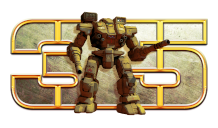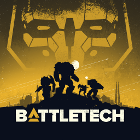- Home
- New To BattleTech?
- MUL
- Forums
- News
- Books
- Shrapnel
- Universe
- Downloads
- Characters
- Community
- Errata
- Links
- Gallery
Handbook House Kurita Developer’s Blog 1
On November 4, 2014
Devotion to duty, perfected through greater self-discipline, leads to an improved state of personal freedom and sense of joy focused on fulfillment in one’s work.
[Commentary: Business is war on the field of numbers. Financial ruin from poor decisions and improper decorum is as deadly as badly considered tactics and unconsidered strategies. In the great machine, one faulty gear can create a catastrophe; one poorly maintained part could destroy a company. It is the duty of the worker to give all he is to the success of his endeavor. For the smallest part plays the largest role in the success or failure of the greater purpose.]
—Dictum Honorium VII, 215–216
Too many years in the making, the advent of Handbook: House Kurita is nearly upon us. The last of the critically acclaimed—but low-selling—Handbook series, it marks the end of the 3067 “era” and provides a comprehensive view of one of the BattleTech universe’s most misunderstood and maligned factions. Grossly sketched as the “evil empire” early on in the game’s creation, the Draconis Combine has turned into one of the most dynamic and culturally rich realms in the current setting. This particular stellar empire survives on the sheer force of will of its ruling House, the Kurita clan. As the family went, so did the Combine.
Anyway, one of the earliest sections I’d completed back in 2011 was the chapter describing the Pillar of Jade—the economic structure of the realm. One of the key pieces within this chapter are the corporate sketches of the Combine’s industrial might. For the Combine, industry is divided along two lines—those that support the military, and everything else. The Draconis Combine’s reliance on the military is a major cornerstone of its existence and key to its continued survival.
Also important in this particular section is a look at the Combine’s economy (specifically, how it is based almost entirely on the success and failure of its military tradition), monetary system, corporate structure, trade, and business perspective. All of these aspects are critical to understanding why the Pillar of Jade is such an important cornerstone to the Combine’s success despite its restrictions, especially compared the (relatively) free markets of the Lyran Commonwealth and Federated Suns—House Kurita’s chief rivals in the struggle to become First Lord of the original Star League.
One of the more difficult aspects of writing this book was making sure that information and secrets later divulged in the fires of the Jihad are not revealed. Sometimes, this meant some form of obfuscation or, in a couple of cases, outright “lies,” that are couched in the perspective of the book’s narrative voice. If the reader looks closely at various areas, especially those touched by story elements in the later Jihad plot books, then the foundation of those arcs can be seen.
But like all things Kuritan, truth is often outed through the perspective of the beholder—after much contemplation, of course.
Enjoy these two corporate previews from the Pillar of Jade.
~Ben H. Rome
BattleTech Assistant Line Developer
Midway Shipyards
Main Headquarters: Orbital (Midway)
CEO: Lawrence Maas
Main Products (Midway; Midway Shipyards): Inazuma-class, Kirishima-class, and Kyushu-class WarShips
Main Products (Schuyler; Dharma HyperSpace) Scout-class JumpShip
Profile: Considered the Combine’s experts in WarShip construction, Midway Shipyards began originally as a JumpShip manufacturer. Its first slips, still in orbit around the planet Midway, produced Star Lord– and Invader-class vessels for the Dragon. Midway-built JumpShips were known for their solid construction and had fewer breakdowns and repair issues than other similar class vessels.
Midway was given the DCA’s contracts for the Inazuma-, Kirishima-, and Kyushu-class WarShips based on their exemplary record. The contracts included a massive series of grants to increase the Midway yards, tripling the company’s size in less than four years. Midway’s increase in fortune has trickled down to the planet proper, providing a level of comfort and satisfaction rarely found among other corporations of the same size.
The shipyards produce an average of one to three JumpShips a year as resources are reallocated to the WarShip program.
Isesaki Shipping
Headquarters: Ukonsoi (Isesaki)
CEO: Daimyo Ernest Machida
Main Products: Interstellar shipping, small craft, cargo modules, Roku Royal land train, Tramp-class JumpShips
Profile: Isesaki Shipping dates back over five centuries. Though the firm has undergone changes and restructuring over time, Isesaki holds a royal patent to trade anywhere in the Inner Sphere. Turbulent relations between the Combine and its neighbors have sometimes made these operations difficult, but Isesaki’s agents and extensive contacts with “independent” traders have always allowed the company to find a way to its goals.
Rumors among Imperial courtiers typically place Isesaki’s free-rein mandate in league with ISF operations beyond the Combine border. While no evidence has ever surfaced that the transport company is simply an extension of the security force, the ISF has been known to place agents on more far-reaching routes.
In addition to its primary business concern of interstellar shipping, Isesaki has branched into other related products and services. The company is the primary domestic shipping provider on the bulk of the Combine’s planets. Isesaki’s manufacturing arm produces several types of all-purpose cargo modules, the popular Roku Royal land train, and a handful of Tramp-class JumpShips every few years. These vessels are built directly for the company; retired JumpShips are often sold at auction to independent buyers and some small shipping concerns.
Currently, the company is wrapping up construction on its new orbital manufacturing facilities over Luthien. The interlinked stations are slated to produce Isesaki’s new Roku Royal II tracked land train.








